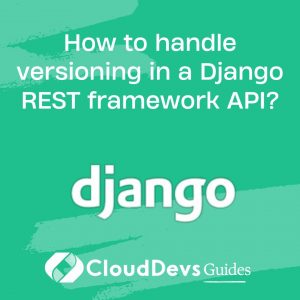Django Q & A
How to use Django with a continuous integration and continuous deployment (CI/CD) pipeline?
Integrating Django with a Continuous Integration and Continuous Deployment (CI/CD) pipeline is a best practice for automating the testing, building, and deployment of your web applications. Here’s a step-by-step guide on how to achieve this:
- Set Up Version Control: First, make sure your Django project is version-controlled using a platform like Git. Host your repository on platforms like GitHub, GitLab, or Bitbucket.
- Choose a CI/CD Service: Select a CI/CD service that fits your needs. Popular options include Jenkins, Travis CI, CircleCI, GitHub Actions, and GitLab CI/CD. These services provide infrastructure for running automated tasks.
- Configure CI/CD Pipeline: Create a configuration file (e.g., `.travis.yml` for Travis CI or `.gitlab-ci.yml` for GitLab CI) in your repository. Define the steps for your CI/CD pipeline, including tasks like installing dependencies, running tests, and building your Django application.
- Environment Variables: Store sensitive information such as database credentials and API keys as environment variables in your CI/CD service to keep them secure.
- Automated Testing: Set up automated testing in your CI/CD pipeline using testing frameworks like Django’s built-in `unittest` or third-party libraries like `pytest`. Ensure that your tests cover different aspects of your application, including unit tests, integration tests, and end-to-end tests.
- Building and Packaging: Create a production-ready build of your Django application, which typically involves collecting static files, compiling assets, and configuring settings for production. Create Docker containers if you plan to deploy with Docker.
- Database Migrations: Include database migrations in your CI/CD pipeline to ensure that changes to your database schema are automatically applied when deploying to production.
- Deployment: Deploy your Django application to a staging or production environment. CI/CD tools can automatically deploy to cloud platforms like AWS, Heroku, or Azure. Alternatively, you can deploy to your own servers using tools like Ansible or Docker Swarm.
- Monitoring and Alerts: Set up monitoring tools like New Relic or Sentry to track application performance and errors. Configure alerts to notify you of critical issues.
- Rollback Plan: Always have a rollback plan in place in case a deployment goes wrong. This might involve reverting to a previous version of the application.
- Logging: Implement thorough logging in your Django application, and make sure your CI/CD pipeline collects and aggregates logs for debugging purposes.
- Scheduled Jobs: If your application relies on scheduled tasks (e.g., periodic data updates), schedule these tasks within your CI/CD pipeline.
- Documentation: Maintain detailed documentation on your CI/CD pipeline setup so that the entire development team understands the process.
By integrating Django with a CI/CD pipeline, you can automate the entire development workflow, from code changes to deployment. This ensures consistency, reliability, and the ability to quickly respond to changes and issues in your application, ultimately improving the overall development and deployment process.

Previously at


Argentina

GMT+2
Experienced Full-stack Developer with a focus on Django, having 7 years of expertise. Worked on diverse projects, utilizing React, Python, Django, and more.


